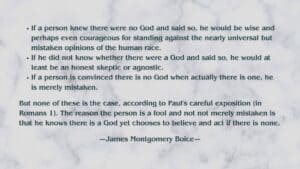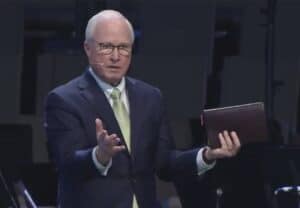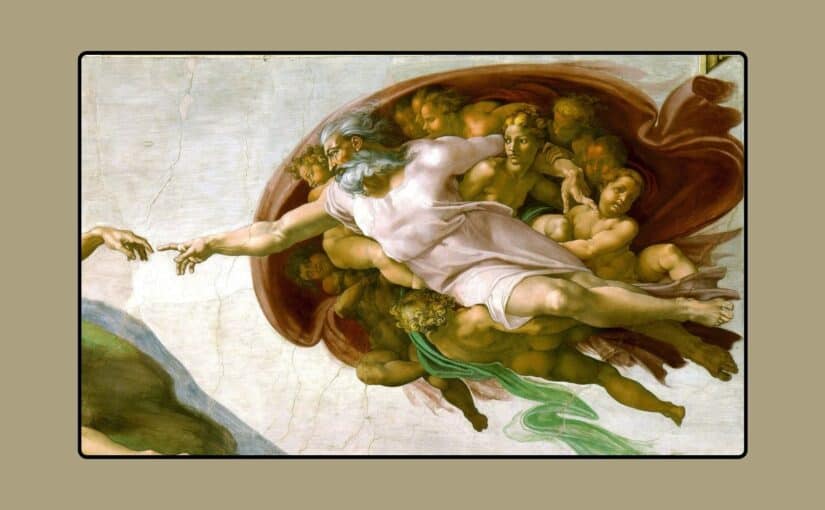— Made in God’s Image, a 10-Part Bible Study Series —
What exactly does being made in God’s image mean? What are some of the practical implications?
An overview of this Bible study series is available here.
An article introducing part 1 is available here.
This is a teaching plan for the first session.
My experiences with science led me to God. They challenge science to prove the existence of God. But must we really light a candle to see the sun?
—Wernher Von Braun—
Atheism turns out to be too simple. If the whole universe has no meaning, we should never have found out that it has no meaning.
—C.S. Lewis—
Welcome the members of your Bible study group. Begin with prayer, asking God to guide your group and to awaken each participant to the importance of the imago Dei (being made in God’s image), especially at this critical moment in our nation’s history.
Use two or three of the following discussion starters to introduce the theme of this Bible study series.
-
- Are there significant differences between the way the church and the culture view what it means to be human? If so, what are some of these? How can the church sharpen its view of what it means to be human? In other words, what are some things it can do to make sure it believes and is promoting authentic biblical teachings on this topic?
- How can the church encourage the culture to embrace a biblical perspective on what it means to be human?
- What do you believe is the meaning of the biblical teaching that God made, and makes, people in His image?
- How is the image of God in people being assaulted today? What are some of the reasons for this? What is the remedy for this?
- Why is it critically important for the church to sharpen its understanding of the image of God — the imago Dei — in human beings? In what ways, and to what extent, has the cultural perspective of what it means to be human infiltrated the church?
- Discuss: When taken seriously and accepted as true, the biblical teaching of what it means to be human can act as an antidote to many of the problems facing American society today. Could this be true? Explain your answer.

Introduce today’s Bible study topic: Let’s begin exploring the theme of the imago Dei. To do that, we first need to consider a core component of the biblical worldview: God exists.
Summarize for your participants the conversation between college student Alan Wilson and his pastor, Matt Thomas, described in the article introducing this Bible study. Briefly discuss the key difference between the two worldviews between which Alan found himself caught.
 These two belief systems — the secular, materialistic worldview and the biblical worldview — “espouse contradictory ideas about God’s existence” (see the first item in this article under “Polar Opposites”). Secularism believes God isn’t, and the biblical worldview states that God is.” Dr. James Dobson highlighted this major difference in Children at Risk,1 a book he co-authored with Gary Bauer in 1990. While Dr. Dobson is correct that clearly the “moral free-fall [precipitated by culture’s jettisoning the biblical worldview and replacing it with one that rejects God] was liberating in its early days, as self-discipline and restraint yielded to a less demanding master. And it caught on like wildfire.” Gradually and inevitably, however, this “liberation” gave way to a form of bondage that is powerfully oppressive. It’s deceptive, too; because often those who believe they have been liberated are blind to the ways the lies they’ve accepted actually are exploiting and abusing them.
These two belief systems — the secular, materialistic worldview and the biblical worldview — “espouse contradictory ideas about God’s existence” (see the first item in this article under “Polar Opposites”). Secularism believes God isn’t, and the biblical worldview states that God is.” Dr. James Dobson highlighted this major difference in Children at Risk,1 a book he co-authored with Gary Bauer in 1990. While Dr. Dobson is correct that clearly the “moral free-fall [precipitated by culture’s jettisoning the biblical worldview and replacing it with one that rejects God] was liberating in its early days, as self-discipline and restraint yielded to a less demanding master. And it caught on like wildfire.” Gradually and inevitably, however, this “liberation” gave way to a form of bondage that is powerfully oppressive. It’s deceptive, too; because often those who believe they have been liberated are blind to the ways the lies they’ve accepted actually are exploiting and abusing them.
Emphasize that one’s belief in God’s existence or non-existence makes all the difference in the world, not only in
-
- how one sees life, right and wrong, and the world around him, but also in
- how one lives his or her own life.
Explain that in this Bible study session, you will explore the biblical teaching of God’s existence and examine evidence for it. Here is an outline:
-
-
- Fools Deny God’s Existence
- God has revealed Himself in Nature
- People Intuitively Know and Understand God Exists
- People Want to Justify Living However They Wish, so They Willfully Ignore the Truth
- God Welcomes Those Who Seek Him Earnestly and Brings Fulfillment to All Who Are Willing to Approach Him on His Conditions
-
1. Fools Deny God’s Existence
Ask a volunteer to read each of these passages: Psalm 14:1-3; Psalm 53:1; Psalm 74:22. Note that the Hebrew word translated fool in 14:`1 and 53:1, and translated foolish man in 74:22, describes a person who is “foolish, senseless, especially of the man who has no perception of ethical and religious claims, and with collateral idea of ignoble, disgraceful….”

Ask a volunteer to read Psalm 92:5-6. Share that the Hebrew word translated fool in verse 6 means “stupid fellow, dullard, simpleton, arrogant one.”
Discuss: Why is an atheist described as a fool in Scripture? Give participants time to respond. Here are some possible answers.
-
-
- The atheist has no valid explanation for the ordered universe in which he lives or for self-evident moral truths.
- He has to believe that everything came from nothing, that complexity arose from chaos, and that the immaterial came into being from the material only.
- She not only is denying God’s existence; she also is acting as her own god.
- The atheist has no reasonable explanation for origins, life, reality, death, or moral values.
-
2. God Has Revealed Himself in Nature
Ask a volunteer to read Psalm 19:1-6. Discuss: Based on this passage, what message is nature declaring? Is there anyone who can’t understand it? Why or why not?
The ripped book — an illustration. Ask: Just how do the testimony of nature and what we read in the Bible fit together? Francis Schaeffer offers an illustration that brilliantly answers this question.2 Here’s a summary of his analogy. Dr. Schaeffer’s illustration and the discussion starters presented below are available in a reproducible PDF file here.

Suppose we are walking through a forest, and we come upon a two-story cabin. We begin to explore the inside of the cabin, and on the first floor we find a table. On the table we discover the bottom portion of a book that has been ripped in two, leaving about one inch of type on each page. We can read what is printed on the bottom of these pages, but we cannot decipher the entire story, the complete message of the book’s author. Of course, no one among us ever would suggest that what we see before us has come into being by chance. An intelligent being is the clear source of the section of the book we are examining with great curiosity.

No one among us ever would suggest that what we are seeing has come into being by chance. An intelligent being is the clear source of the section of the book we are examining with great curiosity.
As we continue exploring, we go upstairs and find the top portion of the same book. We now can bring the two sections of the book together and at last can read the entire message of the author. We can understand the complete story he sought to convey when he wrote. Moreover, through the book, we can get to know the author. This is especially true because in the book, the author tells us about himself.
The bottom portion of the book—the section we discovered on the first floor—represents nature, the world around us, the cosmos, and the created order. The top section represents the Scriptures; in them nature is explained. Further, as we read the top and bottom pages together, the bottom pages make much more sense; nature’s testimony aligns with what the Scriptures tell us.
There’s more! It should not surprise us that what the bottom pages tell us coincides with all we learn from reading the top part of the book. We now understand not just “what,” but “why.” Our questions about life and nature are answered in the Bible—not exhaustively, but adequately. We learn why evil exists in the world. We can understand how nature reflects God’s perfect character, even though the world, the people in the world, and even the universe itself have been marred and damaged by sin and evil. Furthermore, in reading of God’s solution to the mess we’re in, we discover that we can respond to Him in a personal way because He has revealed Himself personally to us. God didn’t just unveil Himself in nature and in the Bible; He also came and lived among us personally in and through His Son, Jesus Christ.
Questions for reflection and discussion:
-
- We’ve acknowledged that though incomplete, the bottom portion of the ripped book we discovered in the first floor of the cabin never could have come into being by chance. Why is this the case? What does this imply about those who say God doesn’t exist?
- Artists typically sign their drawings and paintings in the lower right-hand corner of their works. God signed His name and revealed truth about who He is in the top portion of the ripped book — the Scriptures. Even so, we might say that “His fingerprints are all over nature and the world around us.” Because they are, we can learn important truths about Him just by observing nature. What can you learn about God by observing nature and the world around you?
- Describe some of the ways that nature and the observable universe (the bottom portion of the ripped book) and the Scriptures (the top portion of the ripped book) offer a unified message.
Emphasize: Belief in God based on the evidence in nature and in the wider universe is reasonable. Share the following video to demonstrate it makes sense.
This video presents a case that is both valid and compelling. Yet one does not have to understand all the elements of this argument to conclude God exists. While the argument for God’s existence based on God’s handiwork in nature has a level of complexity, it also has a level of simplicity. By this I do not mean the argument is simplistic, but that it can be readily understood, even by those who might not be able to follow all the points in the contingency argument.
Share this observation from evangelist Ray Comfort, which we cited at the beginning of the article introducing this first session: “It is true that you can’t prove a negative. However, the existence of God is provable in the same way a building is positive proof that there was a builder.”
In other words, God’s existence is self-evident. in Romans 1:18-32, we learn that the evidence is so clear that all people are “without excuse” (v. 20). Read, or ask a volunteer to read, that passage.
God’s existence is self-evident.
Ask your participants to recall that Romans 14:1 declares, “The fool has said in his heart, ‘There is no God.'” In a sermon he preached on Psalm 14, Dr. James Montgomery Boice cited Romans 1 to explain why the individual who says God doesn’t exist is a fool.
If a person knew there were no God and said so, he would be wise and perhaps even courageous for standing against the nearly universal but mistaken opinions of the human race. If he did not know whether there were a God and said so, he would at least be an honest skeptic or agnostic. If a person is convinced there is no God when actually there is one, he is merely mistaken. But none of these is the case, according to Paul’s careful exposition. The reason the person is a fool and not not merely mistaken is that he knows there is a God yet chooses to believe and act if there is none.…

[H]ow does the person actually know there is a God? The answer Paul gives is: because of God’s revelation of himself in nature. It is not an extensive revelation. In fact, as Paul states, it consists of two things only: God’s “eternal power and divine nature,” what we would call his power and mere existence (Rom. 1:20). Nothing in nature reveals God’s saving qualities: his love, mercy, and compassion. But what is revealed — these two important elements — is sufficient to prove to any honest man or woman that God truly does exist and to lead the person to conclude that every member of the human race owes this God praise and thanksgiving. To refuse to acknowledge him is not only wrong; it is the height of folly.
But perhaps the evidence for God is not clear, one might object. Or perhaps the human being just does not have the capacity for perceiving or understanding the revelation. That will not do, says Paul, for God has made the revelation of himself so clear that it has been clearly seen and understood by all. They are without excuse for failing to seek God out and then praise and thank him. His words are: “What may be know about God [that is, from nature] is plain to them, because God has made it plain to them. For since the creation of the world God’s invisible qualities — his eternal power and divine nature — have been clearly seen, being understood from what has been made, so that men are without excuse” (vv. 19-20).
According to these verses, the revelation of God in nature is not hidden so that only a highly skilled scientist may find it. It is open and manifest to everyone. A child can see it. There is enough evidence of God in a snowflake, a fingerprint, a flower, a drop of water to lead any honest member of the human race to believe in God and worship him. Every single object in the world shouts “God” to humanity.3
3. People Intuitively Know and Understand God Exists
Read, or ask a volunteer to read, Romans 2:14-16. Discuss the meaning of the phrase “written in their hearts” (v. 15). Ask: What is written on the hearts of the Gentiles (people who, unlike the Jews, were not the direct and initial recipients of God’s law)? The New International Version (NIV) puts it this way: “the requirements of the law are written on their hearts.” People have an innate understanding of right and wrong, especially as reflected in law of God as presented in the Ten Commandments.
If God does not exist, then neither can objective moral values. Why? Matter and random forces are amoral, or morally neutral. Yet the awareness of right and wrong in human hearts and minds is indeed present and real. This is a clear indication God exists. This is called the moral argument for His existence. Without God, only material, random forces would be responsible for reality as we know it — yet reality as we know it could not have resulted with only random forces influencing matter. Matter is and must be totally values-neutral — and people are not values-neutral.

In this video, author, speaker, and Christian apologist Frank Turek explains in concise terms the moral argument for God. The following short audio clip comes from that video.
In the same video, Turek illustrates the reality that all people know that murder is wrong — in other words, that objective moral truth really does exist.
The Moral Argument for God’s existence is presented in greater detail in this excellent video.
Distribute this handout to each participant and ask everyone to read it silently. After you’ve given your class members time, ask them to locate the phrase “Law of Nature” and underline it. On the handout it appears twice. Ask: What is the “Law of Nature,” according to Lewis?

C. S. Lewis noted that people have an innate sense of right and wrong. Relativism is very much “the thing” among Americans today, including, unfortunately, many who claim to be Christians. They have bought in to the lie that one person’s opinion is just as valid as another’s. “Of course, you can make up your own truth and live by it!” we’re frequently told. And we’re accused of being intolerant if we disagree with this idea. Yet even the individual who declares this to be the case will be the first to cry “Unfair!” if his wallet is stolen or if someone snatches her purse. Here’s how C. S. Lewis put it.
Whenever you find a man who says he does not believe in a real Right and Wrong, you will find the same man going back on this a moment later. He may break his promise to you, but if you try breaking one to him he will be complaining “It’s not fair” before you can say Jack Robinson. A nation may say treaties do not matter, but then, next minute, they spoil their case by saying that the particular treaty they want to break was an unfair one. But if treaties do not matter, and if there is no such thing as Right and Wrong—in other words, if there is no Law of Nature—what is the difference between a fair treaty and an unfair one? Have they not let the cat out of the bag and shown that, whatever they say, they really know the Law of Nature just like anyone else?
It seems, then, we are forced to believe in a real Right and Wrong. People may be sometimes mistaken about them, just as people sometimes get their sums wrong; but they are not a matter of mere taste and opinion any more than the multiplication table.
Give each participant a copy of this handout and encourage everyone to read it before the next session.
Atheist Madalyn Murray O’Hair once said, “An Atheist believes that a hospital should be built instead of a church. An atheist believes that deed must be done instead of prayer said. An atheist strives for involvement in life and not escape into death. He wants disease conquered, poverty vanished, war eliminated.” This statement is carved in granite on a monument that stands outside the Bradford County Courthouse in Starke, Florida.

As one who denied the existence of God, Ms. O’Hair actually had no rational foundation to appeal to intrinsic values. Nor did atheist Robert Green Ingersoll when he said, “The hands that help are better far than lips that pray.” Why? As we have indicated, if God doesn’t exist, good and evil cannot exist either — only matter, and matter is morally neutral. We therefore are justified in asking the atheist these and similar questions.
-
- What makes a hospital a good thing?
- What makes “a deed done” (and here Ms. O’Hair obviously meant a good deed done) desirable in the first place?
- On what basis is it desirable that “disease [be] conquered, poverty vanished, war eliminated”?
And yet, Christians not only have a philosophical basis for intrinsic moral and ethical values; they also have a track record of acting in accordance with those ideals. Share the following video with your group.
Not only do Christians acting to make things better in the world reflect God’s image in their actions; but atheists, by acknowledging the existence of good and evil also demonstrate that they, too, have been created by God in His image. We might put it this way: In trying to make a case that God doesn’t exist, atheists actually offer evidence refuting it.
Direct your participants’ attention to Acts 17:22-31. State that in this passage we see evidence of the innate human understanding of God’s existence. Ask: Where in this passage do we see it?
4. People Want to Justify Living However They Wish, so They Willfully Ignore the Truth
Psalm 10:4; John 3:16-21; 1 Corinthians 2:14; Ephesians 4:17-19
Distribute this worksheet to your participants and give them a few minutes to respond in writing to the questions asked. Point out that even though God has made human beings in His image, many people today attempt to make God in their own image.
Even though God has made human beings in His image, many people today attempt to make God in their own image.
Remind your class members of the observation Matt Thomas offered Alan Wilson in the article that introduces this study: Anyone claiming that
-
- an objective standard of right and wrong doesn’t exist and that
- therefore people can make up their own truth
have embraced a worldview that assumes God doesn’t exist. Pastor Thomas pointed out that such a person may claim to believe in God, “but think about it—the God in which he believes permits people to do whatever they feel like doing. That doesn’t sound like much of a God, does it?”
Emphasize: If God exists, He is above us in relation to His authority, not beside us or beneath us. We are accountable to Him.
Share that Christian theologian and apologist William Lane Craig has stated, “No one in the final analysis really fails to become a Christian because of lack of arguments; he fails to become a Christian because he loves darkness rather than light and wants nothing to do with God.”
5. God Welcomes Those Who Seek Him Earnestly and Brings Fulfillment to All Who Approach Him on His Conditions
Point 5 consists of two parts.
First, God welcomes those who seek Him earnestly.
If time allows, ask seven volunteers to read the following verses: Isaiah 1:18; 55:5-7; Psalm 46:8-10; Proverbs 9:10; John 4:24; John 14:21; and Hebrews 11:6.
Share this PragerU video with your participants. It emphases the truth of Proverbs 9:10.
Here is an important takeaway: God brings fulfillment to all who are willing to approach Him on His conditions.
When we approach God on His conditions, we are acknowledging that He is God and that we are not. Psalm 100:3 declares,
Know that the LORD, He is God;
It is He who has made us, and not we ourselves;
We are His people and the sheep of His pasture.
Here is Psalm 100:3 in the New International Version.
Know that the LORD is God.
It is he who made us, and we are his;
we are his people, the sheep of his pasture.
On Sunday, February 18, 2024, Dr. Bruce Chesser, pastor of the First Baptist Church in Hendersonville, Tennessee, highlighted the need to come to God on His conditions, one of which is to enthrone Jesus and to follow Him, trusting in Him and Him alone for salvation.

This audio clip is less than two minutes long.
Share that Augustine (354-430), an early Christian leader, declared, Because God has made us for Himself, our hearts are restless until they rest in Him.” Augustine prayed, “Oh, God, to know you is life. To serve You is freedom. To praise you is the soul’s joy and delight. Guard me with the power of Your grace here and in all places. Now and at all times, forever. Amen.” Further, Augustine said, “God loves each of us as if there were only one of us.” Yes, God does love us. But He does not cease to be God. We can pretend he isn’t, but if we do, we will pay a heavy price.
Second, God brings fulfillment to all who approach Him on His conditions.
When we affirm that God is and adjust our lives accordingly, we are blessed. As the following verses affirm, God, through His Son, saves those who place their faith in Him, and gives them fulfillment and meaning.
Jesus made (and Scripture makes) some bold claims. These verses contain some of them.
John 1:1,10-14; John 6:35; John 8:12; John 10:9-11; John 11:25-26; John 14: 6; John 15:5
Briefly discuss John 10:9-11. Discuss the Jesus’ claims to be “the door” and ‘the good shepherd” were claims to bring forgiveness, salvation, meaning, and purpose to His followers.
If time allows, explore other passages as well — but if you’re short on time, encourage participants to explore the above passages, which are listed in the handout you’ll distribute momentarily.
Christian leader Bill Bright (1921-2003), said this: “As you love God and serve Him, you will undoubtedly experience the greatest adventure life has to offer.”
Conclusion for Session 1
This handout provides an overview of Session 1. Give a copy to each participant and encourage everyone to review it before the next session. Remind them also to read this short article, which you handed out earlier.
Let your participants know that next time you’ll be discussing the biblical teaching of imago Dei — the teaching that God made, and makes, human beings in His image.
Close in prayer.
Copyright © 2024 by B. Nathaniel Sullivan. All rights reserved.
Notes:
1Dr. James Dobson, in “The Second Great Civil War,” Chapter 2 of Children at Risk: The Battle for the Hearts and Minds of Our Kids, (Dallas: Word Publishing, 1990), 20-21. Dr. Dobson co-authored this book with Gary Bauer.
2Francis A. Schaeffer, The God Who is There: 30th Anniversary Edition (Downers Grove, Illinois: InterVarsity Press 1998, 1982, 1968), 137-138.
3James Montgomery Boice, Psalms, Volume 1: Psalms 1-41 — An Expositional Commentary, (Grand Rapids: Baker, 1994), 114-115.
Unless otherwise indicated, Scripture has been taken from the New King James Version®. Copyright © 1982 by Thomas Nelson, Inc. Used by permission. All rights reserved.
One passage has been cited in The Holy Bible, New International Version®, NIV® Copyright © 1973, 1978, 1984, 2011 by Biblica, Inc.® Used by permission. All rights reserved worldwide.
